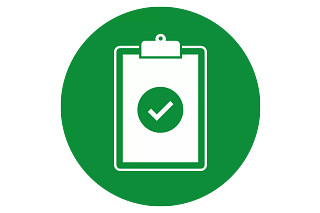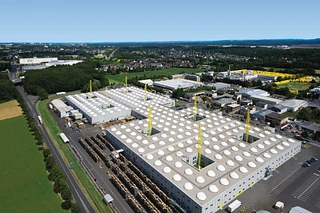Change Language :
Machine Heat Recovery System - the igus heating concept with waste heat
Since 2021, we have been using 100% green electricity at our production site in Cologne. We have replaced old injection moulding machines with new ones that are 40% more energy-efficient, which has enabled us to reduce our electricity consumption by 11% in relation to the increase in production hours. We use gas for heating in our production and office buildings. We switched to climate-neutral gas in 2021, but we were concerned that we were using resources for heating where enough heat is generated, namely at the injection moulding machines. And as of 2023, we have around 800 of these, spread across several buildings.
How do we manage to utilise the waste heat? A team of igus® engineers asked themselves this question and started to try it out. The result: the concept for a heating system that works without gas by utilising the waste heat from the machines. The plan: to stop heating any buildings in Cologne with gas and to make the concept freely accessible to engineers and mechanical engineers, i.e. industry.

Schematic representation of the heating concept
The idea
During the injection moulding process, the hydraulic motors of the injection moulding machines become hot. To prevent them from overheating, the motors are cooled with cooling water. The cooling water is provided by cooling towers, from which the cold water is pumped to the machines. There, the cooling water absorbs the waste heat from the motor and is heated and fed to the fan heater. A fan located on the fan heater heats the sucked-in air and thus heats the hall. At the same time, the heated cooling water cools down during this process and is pumped back to the cooling tower and the process starts all over again.
The system is variably customisable and allows constant temperatures to be maintained even in certain production areas. It does not utilise the diversions via a heat exchanger, which would lead to temperature losses. Additional heating of the water using compressors is also not necessary. As heat is extracted from the hot water as it passes through the fan heater, the cooling requirement of the cooling tower is also reduced, which in turn saves energy.

Detailed view of the control unit
The control unit in detail
The device developed by our engineers ensures that a fan heater within the production hall is supplied with maximum heat energy and at the same time prevents machines from being damaged by excessively high temperatures in the return flow.
The heated cooling water from the machines enters the device via the inlet on the right-hand side of the device. Water flows via the electrically adjustable ball valve to a flow meter that measures the temperature. The temperature of the cooling water in this area must be at least equal to the desired room temperature so that the water can continue to be channelled to the fan heater via the dirt trap and the manual ball valve. Otherwise, the electric ball valve blocks the passage and opens the bypass via the electric ball valve. The water cools down as it passes through the fan heater. This temperature is recorded by the temperature sensor. The heating power of the fan can be calculated from the temperature difference and the flow rate, which is shown on the display. As there is hot water inside the cable, the device can be locked to prevent burns. As there is always dirt in the return pipes, a dirt trap is used to filter coarse particles. The ball valve can be switched manually so that it can also be replaced from time to time. This prevents all the water from the fan heater from flowing back down and flooding the appliance.

What happens next
Sometimes it goes quickly from idea to realisation, as was the case with our "hall heating" project. You test and try things out and suddenly the breakthrough comes and your colleagues can work in their T-shirts even though the gas has been turned off. trade show as of April 2023, we are in the process of preparing our concept so that we can make it available free of charge. We will be talking about it at Hannover Messe 2023. If you would like to find out when and how you can benefit from our waste heat concept, subscribe to our newsletter or check this page regularly.
More about igus®

Open & flexible - The igus® factory
It's not just our heating system that is special, our building structure itself is too. The architecture of our headquarters in Cologne follows the guiding principle that our customers are at the centre of everything we do. From a distance, you can see the sun-yellow pylons towering into the sky, supporting the old and new factory buildings. They have no walls and can be flexibly remodelled and extended.


